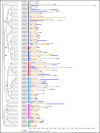Genome-wide Identification of WRKY transcription factor family members in sorghum (Sorghum bicolor (L.) moench)
- PMID: 32804948
- PMCID: PMC7430707
- DOI: 10.1371/journal.pone.0236651
Genome-wide Identification of WRKY transcription factor family members in sorghum (Sorghum bicolor (L.) moench)
Abstract
WRKY transcription factors regulate diverse biological processes in plants, including abiotic and biotic stress responses, and constitute one of the largest transcription factor families in higher plants. Although the past decade has seen significant progress towards identifying and functionally characterizing WRKY genes in diverse species, little is known about the WRKY family in sorghum (Sorghum bicolor (L.) moench). Here we report the comprehensive identification of 94 putative WRKY transcription factors (SbWRKYs). The SbWRKYs were divided into three groups (I, II, and III), with those in group II further classified into five subgroups (IIa-IIe), based on their conserved domains and zinc finger motif types. WRKYs from the model plant Arabidopsis (Arabidopsis thaliana) were used for the phylogenetic analysis of all SbWRKY genes. Motif analysis showed that all SbWRKYs contained either one or two WRKY domains and that SbWRKYs within the same group had similar motif compositions. SbWRKY genes were located on all 10 sorghum chromosomes, and some gene clusters and two tandem duplications were detected. SbWRKY gene structure analysis showed that they contained 0-7 introns, with most SbWRKY genes consisting of two introns and three exons. Gene ontology (GO) annotation functionally categorized SbWRKYs under cellular components, molecular functions and biological processes. A cis-element analysis showed that all SbWRKYs contain at least one stress response-related cis-element. We exploited publicly available microarray datasets to analyze the expression profiles of 78 SbWRKY genes at different growth stages and in different tissues. The induction of SbWRKYs by different abiotic stresses hinted at their potential involvement in stress responses. qRT-PCR analysis revealed different expression patterns for SbWRKYs during drought stress. Functionally characterized WRKY genes in Arabidopsis and other species will provide clues for the functional characterization of putative orthologs in sorghum. Thus, the present study delivers a solid foundation for future functional studies of SbWRKY genes and their roles in the response to critical stresses such as drought.
Conflict of interest statement
The authors have declared that no competing interests exist.
Figures







Similar articles
-
Genome-wide identification of the Liriodendron chinense WRKY gene family and its diverse roles in response to multiple abiotic stress.BMC Plant Biol. 2022 Jan 10;22(1):25. doi: 10.1186/s12870-021-03371-1. BMC Plant Biol. 2022. PMID: 35012508 Free PMC article.
-
Genome-wide identification and expression analysis of WRKY transcription factors in pearl millet (Pennisetum glaucum) under dehydration and salinity stress.BMC Genomics. 2020 Mar 14;21(1):231. doi: 10.1186/s12864-020-6622-0. BMC Genomics. 2020. PMID: 32171257 Free PMC article.
-
Genome-wide analysis of WRKY transcription factors in white pear (Pyrus bretschneideri) reveals evolution and patterns under drought stress.BMC Genomics. 2015 Dec 24;16:1104. doi: 10.1186/s12864-015-2233-6. BMC Genomics. 2015. PMID: 26704366 Free PMC article.
-
Genome-wide identification and analysis of ACP gene family in Sorghum bicolor (L.) Moench.BMC Genomics. 2022 Jul 25;23(1):538. doi: 10.1186/s12864-022-08776-2. BMC Genomics. 2022. PMID: 35879672 Free PMC article. Review.
-
Transcription Factors Associated with Abiotic and Biotic Stress Tolerance and Their Potential for Crops Improvement.Genes (Basel). 2019 Sep 30;10(10):771. doi: 10.3390/genes10100771. Genes (Basel). 2019. PMID: 31575043 Free PMC article. Review.
Cited by
-
Recent Duplications Dominate VQ and WRKY Gene Expansions in Six Prunus Species.Int J Genomics. 2021 Dec 17;2021:4066394. doi: 10.1155/2021/4066394. eCollection 2021. Int J Genomics. 2021. PMID: 34961840 Free PMC article.
-
Genome-wide identification of WRKY transcription factor family members in Miscanthus sinensis (Miscanthus sinensis Anderss).Sci Rep. 2024 Mar 6;14(1):5522. doi: 10.1038/s41598-024-55849-1. Sci Rep. 2024. PMID: 38448638 Free PMC article.
-
Characterization of the WRKY gene family in Akebia trifoliata and their response to Colletotrichum acutatum.BMC Plant Biol. 2022 Mar 14;22(1):115. doi: 10.1186/s12870-022-03511-1. BMC Plant Biol. 2022. PMID: 35287589 Free PMC article.
-
WRKY Gene Family Drives Dormancy Release in Onion Bulbs.Cells. 2022 Mar 24;11(7):1100. doi: 10.3390/cells11071100. Cells. 2022. PMID: 35406664 Free PMC article.
-
Candidate Genes for Salt Tolerance in Forage Sorghum under Saline Conditions from Germination to Harvest Maturity.Genes (Basel). 2023 Jan 22;14(2):293. doi: 10.3390/genes14020293. Genes (Basel). 2023. PMID: 36833220 Free PMC article. Review.
References
Publication types
MeSH terms
Substances
LinkOut - more resources
Full Text Sources
Miscellaneous

